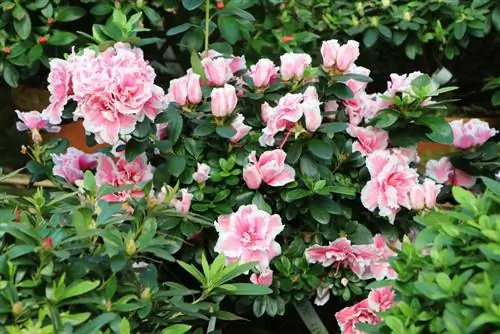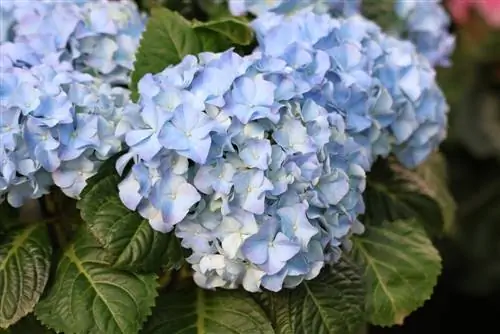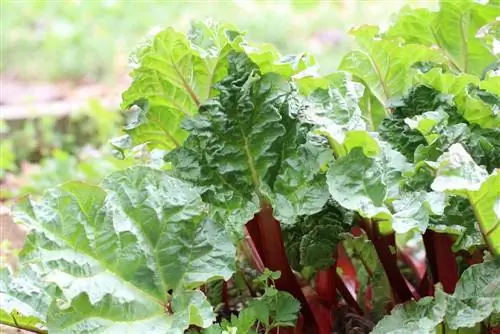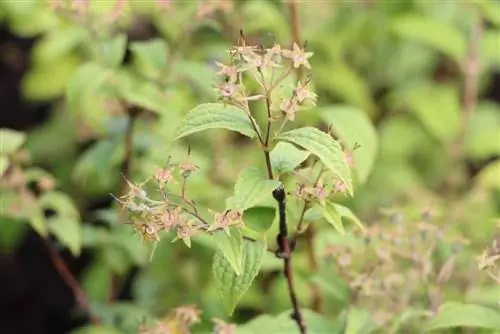- Author admin [email protected].
- Public 2023-12-17 03:39.
- Last modified 2025-01-24 12:45.
Azaleas are true flower manufacturers, regardless of whether their production location is in the garden bed or on the windowsill. Their flowers are so numerous that they could easily supply other plants. The indoor azalea is also friendly in choosing its flowering time. It regularly colors the dreary, gray winter with its flowers. Do cutting measures interfere with their enthusiasm?
Does the azalea need pruning?
Many hobby gardeners don't prune their azaleas at all. However, this is not due to a lack of care or a lack of time. They are more likely to think that a cut is not necessary at all. No wonder, because this belief persists and is often passed on as a recommendation from hobby gardener to hobby gardener. However, there is also a small spark of truth in it. Of course, the azalea does not need any pruning. It grows happily even without a cut. The cut serves the owner and admirer of the azalea, because it gives him plenty of flowers and a beautifully shaped plant. And an azalea is only an azalea if there are no leaves to be seen because of all the flowers. So if you want to marvel at your azalea in its splendid appearance every year, you should give it a suitable cut in good time.
When is the time right for a cut?
Azaleas, like rhododendrons, do not need regular pruning to thrive. Without pruning, the azalea will not die, but it will still continue to grow. But if you take the time and boldly grab the secateurs, your azalea will soon thank you. Beautiful growth and a strong plant will follow. The right time for pruning is immediately after the flowering phase. Rejuvenation pruning should be carried out in March.
Even if an azalea has become too large for its space and can no longer develop unhindered, it must be pruned back into a more compact shape. Because unlike many other trees, an azalea does not like changing locations. So instead of picking up a spade, you have to pick up scissors and a saw.
Removing wilted flowers
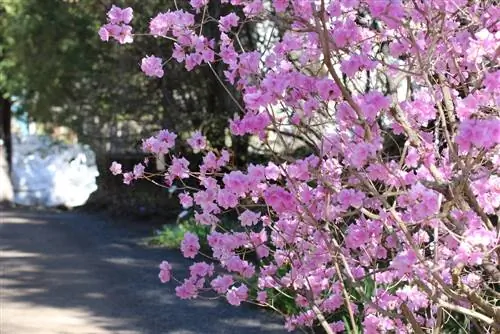
You should remove wilted flowers from your azalea regularly. On the one hand, this care measure has a positive effect on the visual appearance of the azalea. On the other hand, it promotes flowering. The more diligently you remove the withered flowers, the more joy the future blooms will bring you.
- the right time is during/after flowering
- around mid to end of April
- remove all dead plant parts promptly
- As a result, the azalea blooms even longer
- next gardening year the flowers will be even more magnificent
- new buds will soon form on cut shoots
Prevent baldness
If the azalea is fully satisfied with its location and care, it will produce abundant branches and branches. This growth can be so vigorous that the branches are close together. The numerous leaves form their own green roof. The top layer receives plenty of light, while no ray of light penetrates to the hidden parts of the plant. And as we all know, not a single leaf grows without light. To prevent this from happening, the azalea must be thinned out so that light can reach all of its parts unhindered.
- optimal time is the end of the flowering phase
- cut only a few days after flowering
- but definitely before new growth
- pay attention to a nice shape
- it doesn't necessarily have to be cut every year
- Cutting measures are based on requirements
- every 3 to 4 years is usually sufficient
Not all azalea varieties tolerate pruning equally well. Find out exactly what variety your azalea is. Be sure to base the scope of cutting measures on the variety's tolerance to cutting. It's better to take away a little less than too much.
Tip:
Major pruning measures should be spread evenly over two years in order to keep the challenge for the plant smaller.
Lighting step by step
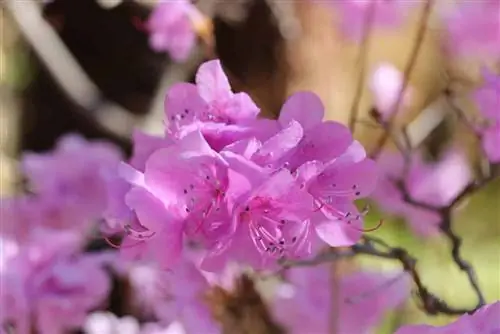
Roses scissors are very suitable for cutting off the branches. For thicker branches you will need a saw. Both garden tools should always be used clean and sharpened.
- First remove dead branches and twigs
- Cut off any broken plant parts
- Take away the branches growing inwards
- Thin branches that cross each other
- Cut annual growth. Cut down to a small shoot, the so-called small eye.
Note:
The interfaces on new growth should be a maximum of 2 to 3 cm in diameter.
Rejuvenation cut
All those parts of the azalea that hardly see the sun will gradually lose their leaves and become bare. Even after regular thinning, this cannot be completely prevented. Therefore, the azalea needs a radical cut every now and then. Even if the plant has become too powerful and has exceeded the available space, rejuvenation pruning can be used. March is a good month for a radical cut. However, the flowering will stop this year and will not start again until next spring.
- all shoots are shortened
- also cut thick branches
- use clean and sharp scissors
- A hand saw is suitable for thick branches
- do not cut with an electric saw
- Cut 30 to 40 cm above the ground
- always cut in the right places
- cut above sleeping eyes
- on old wood, sleeping eyes are just indistinct thickenings
- Eyes can no longer be seen on very old wood
- if no eyes are visible, still cut “somewhere”
He althy azaleas tolerate rejuvenation pruning and will sprout new plants in the coming growing season. Older specimens run the risk of not surviving a radical cut.
Note:
After new growth, any remaining dry stubs must be sawn off down to the top fresh shoot.
Cutting young plants
Azaleas that are still very young and have not yet grown strongly should not be cut at first. However, dead flowers should also be removed regularly so that they form more buds. Only when the young plants have become significantly stronger does further pruning make sense. They primarily serve to train the plant and ensure a beautiful growth habit. Proceed as with the adult specimens. For refined varieties, you must not cut out the grafting area.
Pruning of sick plants

Sometimes azaleas can also be affected by a fungal disease. As soon as you discover the disease, you should take bold action. Cut away all affected parts of the plant so that the disease cannot progress further. Use disinfected cutting tools and disinfect them again after use. Carefully pull out the diseased branches so that the fungus does not come into contact with he althy parts of the plant, if possible. All diseased plant parts belong in the trash. Many fungi survive the decomposition process in the compost heap and can spread further later.
Care after cutting
If pruning is done in spring, the pruned azalea can expect many warm months before winter sets in. So soon after the cut they begin to diligently sprout new shoots. For this growth momentum, they absolutely need enough nutrients and plenty of water. It is best to water the azalea immediately after cutting it back. Afterwards, never let the soil dry out completely. Regularly add suitable fertilizer to your irrigation water until September.
Through thinning out, more sun rays could now reach the root area, which the root area doesn't like. The fine shallow roots could burn from too much sun. Immediately after cutting, shade this area with a layer of mulch.
Cutting indoor azalea
A room azalea can also be cut. If the azalea has become too large over time, it can be brought back into an acceptable shape using pruning shears. You should only use scissors when the last flower has withered. This should be the case around the end of February. Cut away about a third of all shoots. Dead branches must be cut off completely. Then place the pot in a bright place so that the azalea gets enough light for new growth.
Withered flowers should also be removed promptly from indoor azaleas.

